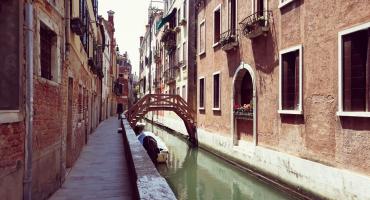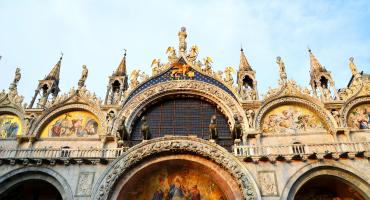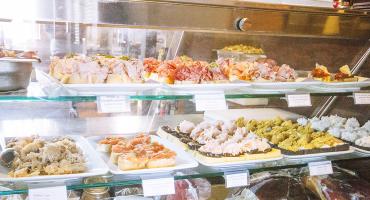Who didn’t stop just once at San Rocco’s Square to listen to the many street performances just beside the church? And maybe sat on the church’s stairs just to give one’s legs some rest after a full day walking around the city, getting lost through little narrow streets and squares, because that’s the beauty of Venice?
Many will identify in this romantic image of Campo San Rocco, both those who played or singed and those spectators of one of these improvised theatres. In this atmosphere belongs a dimension in which the time seems to stop, the location of the Scuola Grande San Rocco, rising up imposing and silent just as an onlooker of the amazement of the passersby.
At first sight what strikes you more of this old building is the white façade with Istrian stone columns in clear contrast with the dark pavement, giving you the feeling to collapse, and it is really natural to look up to the sky to check if the building isn’t actually endless as it seems. If you just stop for a moment to think about it, it is not so strange feeling a little confused in front of such majesticness, since the great splendour of the Barocco style on decorations is at the base of the original design of the School, that had to host no less than the remains of the saint patron of people infected with plague, a real treasure for that period.
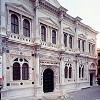 The history of the Scuola Grande di San Rocco started before their construction, indeed, it has been established in 1478, but its member separated between the two churches of San Giuliano and San Silvestro, making their spaces available, waiting for the building of a space dedicated to their community.
The history of the Scuola Grande di San Rocco started before their construction, indeed, it has been established in 1478, but its member separated between the two churches of San Giuliano and San Silvestro, making their spaces available, waiting for the building of a space dedicated to their community.
In 1485, when the remains of Saint Rocco were obtained, the building was still not created, even with the need of finding a place to put the precious treasure.
Only 25 years after, under the supervision of Pietro Bon, architect and designer of the School, started the works of a building that would have risen in the same place of San Pantalon and Basilica di Santa Maria Gloriosa dei Frari. Even if the structure is not so different from the other Venetian schools – two overlapping rooms as building body, linked with a staircase – some disagreements wanted the architect Sante Lombardo, who would be later replaced by Antonio Abbondi, called Scarpagnino, who was the architect of the whole façade, the internal staircase and the one who finished the design.
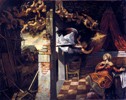 Therefore, at the end, the Scuola Grande di San Rocco is divided in two big Rooms, the Terrena one, with three naves with direct access from the square, and the Superiore one, where processions end and meetings are held. From here you can enter another Room, the Sala dell’Albergo (the “Hotel Room”), built above a porch called “of the Dead”, linked to the square through a secondary gate on the façade. The Sala Terrena and Sala Superiore are linked together to an internal staircase, called “a tribunale”, ending with a ledge protected by a dome which opens on the Sala Superiore.
Therefore, at the end, the Scuola Grande di San Rocco is divided in two big Rooms, the Terrena one, with three naves with direct access from the square, and the Superiore one, where processions end and meetings are held. From here you can enter another Room, the Sala dell’Albergo (the “Hotel Room”), built above a porch called “of the Dead”, linked to the square through a secondary gate on the façade. The Sala Terrena and Sala Superiore are linked together to an internal staircase, called “a tribunale”, ending with a ledge protected by a dome which opens on the Sala Superiore.
If the structure does not succeed in lending the Scuola Grande di San Rocco a precisely peculiarity comparing to the other Venetian schools, its paintings and decoration do. This building is proud of works by some leading names such as Giorgione, Tiziano, Giambattista Tiepolo and Francesco Pianta, but it is Jacopo Robusti, called Tintoretto, the leader of each Room.
By the Sala Terrena, dedicated to the Virgin and Christ’s childhood, it is clear the style of the very well-known Venetian painter is in its full expression. In paintings such as L’Annunciazione, L’Adorazione dei Magi, La Fuga in Egitto, La strage degli innocenti, La presentazione al Tempio e L'Assunzione di Maria is actually still visible a study of shapes and body expressions to bring out completely human nature of its main characters, that turn from figures on canvas to ordinary men’s everyday feelings.
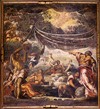 This style is applied by Tintoretto to the paintings decorating the Sala Superiore too, dedicated to the miracles– Mosé fa scaturire l'acqua dalla roccia, Il miracolo del serpente di bronzo, La caduta della manna – and to Christ’s maturity life– Il Battesimo, La probatica piscina, La Resurrezione, L'Ascensione, L'ultima cena, e La moltiplicazione dei pani e dei pesci.
This style is applied by Tintoretto to the paintings decorating the Sala Superiore too, dedicated to the miracles– Mosé fa scaturire l'acqua dalla roccia, Il miracolo del serpente di bronzo, La caduta della manna – and to Christ’s maturity life– Il Battesimo, La probatica piscina, La Resurrezione, L'Ascensione, L'ultima cena, e La moltiplicazione dei pani e dei pesci.
The same style in the Sala dell’Albergo too, with San Rocco in gloria, surrounded by allegorical representations of the other Venetian Schools – San Giovanni Evangelista, San Marco, San Teodoro, della Carità e della Misericordia – and of the Passion and Death of Christ – Cristo davanti a Pilato, Ecce homo, La salita al Calvario, La Crocifissione.
That is the reason why, once stepping inside the Scuola Grande di San Rocco, you will feel part of a by now far world, but deeply present and inclined to getting us involved in what’s happening around us. Not just because the deep communicative charge characterizing Tintoretto’s paintings, but thanks to the plasticity of animals, buildings objects or persons painted. Therefore, we are able to identify the real main character of this thousand-year-old theatre: the light. Every shape is expressed in its concrete peculiarity not only by colours and lines, but also by a study of lights and shadows characterizing the Venetian artist’s painting and making it one of a kind.

